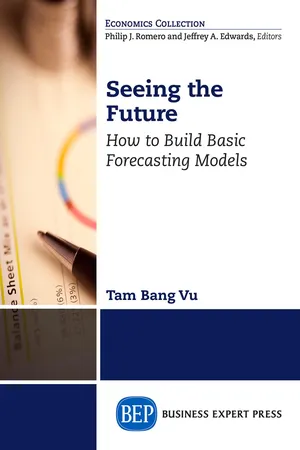![]()
PART I
Basics
This part contains three chapters:
•Chapter 1 Introduction
•Chapter 2 Elementary Time Series Techniques
•Chapter 3 Evaluations and Adjustments
![]()
CHAPTER 1
Introduction
As you know from the preface, Mo works at Motorland in this city to supplement his college expenses. Presently, his boss wants him to estimate the demand for Honda motorcycles from their store next quarter so that they can place an order with their supplier. Here is what his boss says, “Hey Mo, we cannot afford to go by ear any more. Two years ago, we under-ordered and lost at least $10,000 in sales to our local competitors. The following year, we compensated by doubling our order, which left us with a warehouse full of unsold motorcycles. I want to limit our error. I don’t want to under-order or over-order by more than 20 percent. Let’s try to work on it.”
Mo understands his boss’ frustration and collects data on the sales of motorcycles from his store for the past 12 quarters. However, the first day of class will not start until the following week, and Mo does not know how to start his forecasting. Thus, he contacts Dr. Theo, who advises him to read this chapter and says that once he completes it, he will be able to:
1.Describe the basic steps of forecasting.
2.Distinguish qualitative from quantitative forecasting and choose the right method for his estimations.
3.Explain basic concepts of statistics.
4.Apply Excel operations into simple calculations, and chart, and obtain descriptive statistics for his data.
Mo sails through the section on “Starting” and one half of the section on “Basic Concepts” with ease. Here is what he reads in these sections.
Starting
Forecasting is used whenever the future is uncertain. Although forecast values are often not what actually occur, no one can have a good plan without a reasonable approach to form an educational guess on the future, which is called forecasting.
There are four basic steps in forecasting.
Step 1: Determining the Problem
A forecaster has to define what future information is needed and the time frame of the forecasts. For example, a firm must forecast how much of each good it should produce in the next several months so that it can order inputs from the supply chain and make a delivery plan to the market. To make this decision, the forecaster for the firm needs to understand the basic principles in production planning and communicate with people who have access to the monthly output data. The firm’s leaders, then, have to decide how far into the future the information is needed (e.g., a month or a quarter ahead). This future period is the forecast horizon. Finally, the firm needs to decide how often the forecasts have to be updated and revised (e.g., weekly or monthly). This is the adjustment interval or forecast frequency.
Step 2: Selecting the Forecasting Method
Depending on the problem and the availability of the information, an appropriate method of forecasting should be decided. For the preceding example, historical data on the firm’s production, constraints in labor, capital, and raw materials can be obtained. Hence, a quantitative method of a data analysis is appropriate. For many other situations, when historical data are not comprehensive or experiences are more important, a qualitative method utilizing the expertise of the professionals can be employed.
Step 3: Collecting and Analyzing the Data
Data can be collected directly by the user (primary data) or by someone other than the user (secondary data). Data analyses consist of constructing time series plots, obtaining descriptive statistics, and calculating the forecast values. Data analyses are crucial in the process of selecting a reliable model. No single model is good for all situations. When a theoretical model is introduced, data analysis should be performed based on this model. When no theoretical model is developed, a forecaster should experiment with several models. For the example in Step 1, a theoretical model of profit maximization or cost minimization is available and should be used.
Step 4: Evaluations and Adjustments
Evaluations are performed based on historical data to select the best model with the smallest forecast errors. Based on the magnitude of the forecast errors, adjustments are made to the existing models. Monitoring is then carried out because forecasting is a long-term process. Business and economic conditions change over time as do the forecasts. A good forecaster needs to track the changes so that the causes are pinpointed. New forecast errors need to be calculated. Either a new model might be developed, or a combination of several models might be introduced.
Basic Concepts
Qualitative Forecasting
There are three main qualitative methods in addition to the naïve approach of taking the current-period value as the forecast of the next-period value.
Individual judgment is a forecast made by an expert in a field based on the person’s experience, the past performance of the market, and the current status of the business and economy. The expert can employ: (i) analogy-analysis technique by comparing similar items, (ii) analyzing possible scenarios in the near future, or (iii) collecting qualitative data by sending out survey forms to the respondents and performing a qualitative analysis of these data.
Panel of expert...
